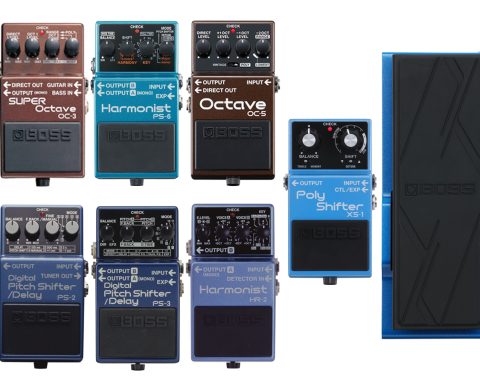While not flashy, an expression pedal can be a powerful tool in a guitar player’s toolkit. Rather than affecting a fixed effect parameter like filter or volume, expression pedals can control many parameters. They work with stompboxes, MIDI controllers, guitar amps, multi-effects units, and synthesizers. With the EV-1-WL, BOSS created the world’s first wireless MIDI expression pedal. First, we’ll look at what an expression pedal can do. Then we’ll dive into the EV-1-WL and learn about its next-level innovations.
The Power of Expression
As a guitar player, you’ve likely used a wah pedal or a volume pedal before. They’re treadle-type floor pedals that allow you to use your feet to control certain aspects of your sound. In the case of a wah, it’s the filter sweep of the effect, while a volume pedal controls your guitar volume.
Perhaps the easiest way to think about an expression pedal is like a remote control for a particular knob on your pedal. It allows you to ramp it up and down, hands-free in real-time. However, while an expression pedal resembles a wah or volume pedal, it operates differently.
"The easiest way to think about an expression pedal is like a remote control for a particular knob on your pedal."
It’s important to note that an expression pedal does not create or contribute any effect or sound in and of itself. Indeed, exactly what parameters you can control will depend on the feature set of the device that it’s connected to.

Expression Pedal Applications
Delay/Reverb
Using an expression pedal can open up new avenues for creativity and musical innovation. Let’s start with something simple but quite handy. Connecting an expression pedal like the BOSS EV-30 can unlock basic “presets” on your DD-8 digital delay. Go from a short slapback to a long lead delay without having to bend over and adjust the knobs or send it into wild self-oscillation at the nudge of your toe.
For advanced users, the EV-30 features dual expression outputs. This means that you can connect and control two different pedals at the same time. The video below puts this feature to great use. Watch and see how to dynamically blend delay feedback levels and swelling into deep cavernous reverbs. The result is the ultimate in ambient guitar explorations.
Modulation
A wah pedal takes up a decent chunk of your pedalboard real estate. For many players, it’s an effect to use sparingly. Why waste the extra space on your board? For example, simply assign the Filter effect on an MD-500 to the expression pedal. You’ve got yourself an instant wah.
An expression pedal provides real-time control of classic vibe effects. Try it for that chewy, vintage warble à la Hendrix and Trower. Listen to the style demonstrated in tasty fashion by Mr. Brett Kingman.
Overdrive
One might not immediately think to use an expression pedal with overdrive. However, with a programmable drive like the OD-200, you can. Just set the expression pedal so as you turn the gain up, you simultaneously dial the volume down. This allows you to smoothly go from clean to scream while still maintaining balanced levels.
Multi-effects
A compact multi-effects unit like the GT-1000CORE benefits immensely from an expression pedal. It can perform most of the applications we’ve discussed, and more. Furthermore, you can utilize the EV-30 with a GT-1000CORE for pitch-shifting, dive-bomb, and drop tune effects on the fly.
"For a relatively straightforward device, the humble expression pedal punches above its weight."
As you can see, the humble expression pedal can cover a lot of ground. For a relatively straightforward device, it punches above its weight. Still, can it get any better than that? We believe so.
EV-1-WL: A New Horizon
The BOSS EV-1-WL is the world’s first wireless MIDI expression pedal. It’s the ideal partner for the growing range of BOSS products and other hardware with Bluetooth wireless support. It also provides cable-free foot control for the synthesizer engine in the EURUS GS-1 Electronic Guitar. This allows players to operate pitch bend, filter, and other assignable functions. Still, that’s not all it can do.
Features
- Connect gear in three ways: Bluetooth wireless, USB, and TRS MIDI.
- Use all three outputs at once with completely independent MIDI CC settings and value ranges for each output.
- Class-compliant: USB is plug-and-play without any need for drivers.
- Get creative with the BOSS EURUS GS-1, Waza-Air, Katana-Air, and any device supporting Bluetooth MIDI.
- Turn any MIDI-compatible gear wireless using the Roland WM-1 and WM-1D wireless MIDI adaptors.
- Use the built-in toe switch for more control, or add up to two BOSS FS-series footswitches to change presets and control functions.
- Assign MIDI CC settings and customize the response of the pedal using the dedicated iOS/Android app.
EV-1-WL Applications
Control Guitar Plug-ins/Apps via Bluetooth
More and more guitar players are turning to computer-based plugins or mobile apps for practice and recording. These can be great when you don’t want to use your physical gear. However, the compromise is losing access to footswitching and expression pedal capabilities.
With the EV-1-WL, connect to your device via Bluetooth and control wah/pitch-shifter effects or other parameters. You’ll have no extra wires trailing to/from your device. Plus, with an additional FS-series footswitch, navigate through presets without interrupting your playing. Below is a video from Rabea Massaad on how to set up your EV-1-WL with plug-ins.
Expand BOSS Gear with Bluetooth
BOSS is on a mission to give guitarists the best possible practice experience. The Waza-Air wireless personal amplification system and Katana-Air wireless guitar amp are examples. Both these units are compatible with EV-1-WL.
Armed with an EV-1-WL and an FS-series footswitch, you’ve got yourself a wireless mini-board. Enjoy hassle-free expression control and preset navigation.
"Armed with an EV-1-WL and an FS-series footswitch, you’ve got yourself a wireless mini-board."
Control Pedals via TRS MIDI
Although the key feature of EV-1-WL is its wireless functionality, it still works perfectly as a standard MIDI expression pedal. A compact 3.5mm TRS MIDI jack means you can connect it via a simple 3.5mm TRS cable to our 200 Series pedals, GT-1000CORE, and other compatible pedals. Alternatively, use our BMIDI-5-35 cable to connect to hardware with traditional MIDI plugs. Examples include the 500 Series pedals and ES switchers.
Remember, EV-1-WL has independent MIDI CC settings for each output. This means when you’re using TRS MIDI with pedals, you won’t need to change the Bluetooth MIDI settings you use with plug-ins.

"An expression pedal in isolation is an opportunity waiting."
Step Into Self-Expression
An expression pedal in isolation is an opportunity waiting. Ultimately, with the right combination of gear, it can enhance and inspire your sound, sending it in a completely new direction. If you’ve been considering getting one, maybe it’s time to take the plunge and begin the journey of self-expression.






